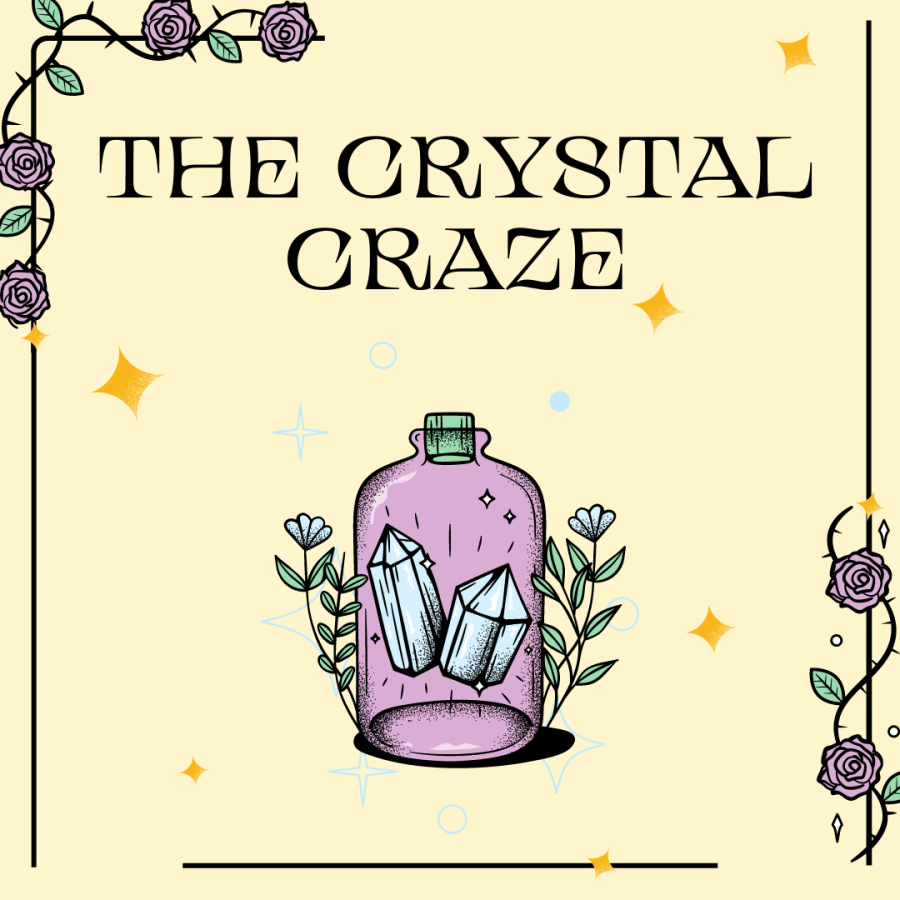The Crystal Craze
Why is everyone so obsessed with rocks?
September 22, 2022
You’ve probably witnessed the rise in popularity of different crystals, gemstones, and rocks. Everywhere you look, someone is sporting a crystal necklace or ring. And everywhere you scroll, someone is raving about the healing properties of these gems. They’ve become especially popular with teens, specifically teenage girls, and have brought practices such as Witchcraft and Paganism out of the dark and onto everyone’s radar.
The origin of crystal symbolism can be traced back to many different cultures and societies. Stanford scholar Marisa Galvez says that their physical qualities make them stand out among other stones. The crystal’s transparent appearance and its ability to refract light are part of why so many ancient civilizations ascribed magical powers to these stones. Writers from the Middle Ages used imagery of crystals in their literature to represent story elements like purity. perfection, and even concepts such as uncertainty in love. In a passage by 12th-century poet Bertran de Born, he compared the teeth of a woman he described to crystal. The passage read: “By…the beautiful smile she gave me, when I saw her teeth of crystal and her body, slim, delicate, and fresh and smooth…she locked up my heart.” The picture he paints with this excerpt helps us understand that crystal symbolism was also used to illustrate desire. In Western Christianity, on the other hand, crystals were often used to decorate important religious objects as it was thought that they “manifested transcendence and the light of the heavens.”
Crystals have always been renowned for their beauty, geology, and supposed metaphysical properties. Though recently, they have been becoming a key component of popular culture. More people than ever seem to be hitting up crystal shops, sporting crystal jewelry, or becoming experts in the identification of these gemstones. Their history in literature does help explain this recent obsession and how they are thought to have magical energy, but that’s not all that explains humankind’s affinity for these rocks. In the Middle Ages, people also thought crystals could summon a spiritual presence. They had a hunger to have a physical manifestation that embodied faith and spirituality, and this desire continues in people today. Crystals fulfill a spiritual need for some individuals. They make some feel one with the Earth from which they came, as these gems are our planet’s stunning natural creations. Some people go to church to feel more connected to their God, some do yoga to feel more connected to their body, and others meditate with crystals to feel more connected to nature.
As our world becomes more progressive, we’re seeing people branch out to different religions and belief systems, some more unconventional than others. The recent popularization of older theologies such as Paganism and modern ones like Wicca has lent a hand in the modern crystal craze. Carrie Eller, a crystal shop owner, explains how gems could have been used in these more ancient practices: “Nobody knows for sure how these cultures implemented them as these were groups of people with no written language to refer to for historical references, however, archeological evidence shows they lived closely with the earth, cycles of the seasons and celestial bodies. And as everything always had meaning and associations with other things, it stands to reason that the use of stones was a part of their culture too.” These belief systems being heavily based on nature goes to show the significance of earthly objects such as crystals to their spiritual needs.
With the rise in popularity of these nature-based belief systems, there is a community of self-proclaimed “witches” forming on social media apps such as TikTok. Videos showing DIY spells and potions are becoming widespread and grabbing the attention of young people, who seem to gravitate towards the unrealistic “get rich quick” scams (in this case, those that defy natural laws). This mindset seems to be common among crystal users specifically. So many people are investing time and money into these (often expensive) crystals, with the faith that they will solve their financial, relational, and emotional problems. Some will keep them in their wallet to bring money and fortune, and some will leave crystals in the home or car of someone they are fond of in hopes of winning their affection. Yet, many of these people will avoid doing the actual work on themselves to improve these aspects of their lives.
Every skeptic is probably wondering, is there any science behind the alleged benefits of crystals? Some would argue that yes, there is. “Scientifically, every object in existence vibrates at its own frequency related to its specific density. This is true for stones, trees, water, and even humans — everything. This can be quantified in a scientific lab and is a vast subject entirely on its own,” said Eller. “When you place objects beside each other, their vibrations affect each other. So, if a specific thing [crystal] has a specific density [frequency], which has a specific meaning and usage, theoretically, utilizing that stone will have an influence on us.” This thought process makes sense to some and draws up even more questions for others. When science and spirituality conflict, there can be a lot of complications. What Eller said in regards to vibrations is scientifically true, but her interpretation of how that ties into crystal healing is unproven and therefore up for debate.
Green Level High School’s own Ms. Conniff studied Geology at Appalachian State University. When asked what about the science of crystals makes people gravitate towards them so much, she said “Well, crystals are typically made of minerals, and they each have a specific crystalline structure that can make them very unique and interesting. I personally think they’re very interesting because they can have perfect structure, like a cube, or a hexagon, or a diamond… and that can make them really fun to collect.” She also thinks the metaphysical properties of crystals are up to interpretation.
“Based on my beliefs, I don’t know the scientific justification behind it [crystal healing], but I also think if people put that intention onto something that it can hopefully come true for them, and if it works for them, it works for them. If they wholeheartedly believe in it, they have every right to collect crystals. I want to collect crystals even though I don’t have that same belief, but I totally understand why. It’s not hurting anyone, besides maybe mining…” Ms. Conniff’s point of view on crystals furthers the idea that science and spirituality can go more hand in hand than we thought, and this apparent overlap may be why these gemstones are getting so much attention (and how that is coming with environmental consequences).
Crystals are gaining popularity by the day, and the explanation of why is not limited to a single answer. How they’re represented symbolically, their supposed magical powers, natural beauty, and spiritual significance, as well as religious tolerance, social media, and actual science, are all to credit for their sudden prominence in our culture.







